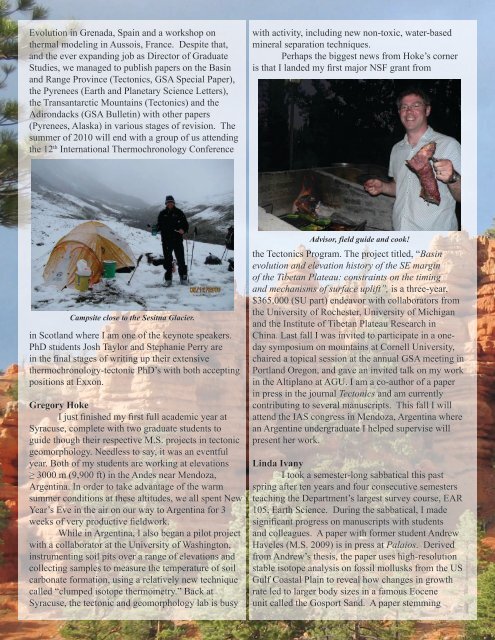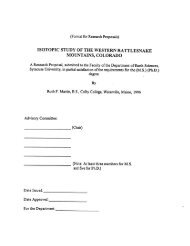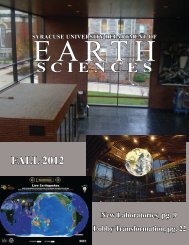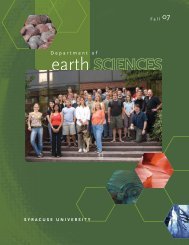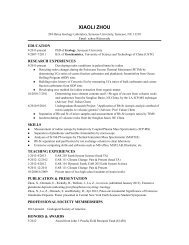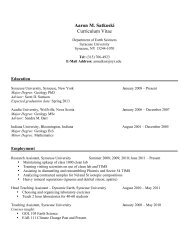alumni reception - Syracuse Universe Department of Earth Sciences ...
alumni reception - Syracuse Universe Department of Earth Sciences ...
alumni reception - Syracuse Universe Department of Earth Sciences ...
You also want an ePaper? Increase the reach of your titles
YUMPU automatically turns print PDFs into web optimized ePapers that Google loves.
Evolution in Grenada, Spain and a workshop on<br />
thermal modeling in Aussois, France. Despite that,<br />
and the ever expanding job as Director <strong>of</strong> Graduate<br />
Studies, we managed to publish papers on the Basin<br />
and Range Province (Tectonics, GSA Special Paper),<br />
the Pyrenees (<strong>Earth</strong> and Planetary Science Letters),<br />
the Transantarctic Mountains (Tectonics) and the<br />
Adirondacks (GSA Bulletin) with other papers<br />
(Pyrenees, Alaska) in various stages <strong>of</strong> revision. The<br />
summer <strong>of</strong> 2010 will end with a group <strong>of</strong> us attending<br />
the 12 th International Thermochronology Conference<br />
with activity, including new non-toxic, water-based<br />
mineral separation techniques.<br />
Perhaps the biggest news from Hoke’s corner<br />
is that I landed my first major NSF grant from<br />
Campsite close to the Sesitna Glacier.<br />
in Scotland where I am one <strong>of</strong> the keynote speakers.<br />
PhD students Josh Taylor and Stephanie Perry are<br />
in the final stages <strong>of</strong> writing up their extensive<br />
thermochronology-tectonic PhD’s with both accepting<br />
positions at Exxon.<br />
Gregory Hoke<br />
I just finished my first full academic year at<br />
<strong>Syracuse</strong>, complete with two graduate students to<br />
guide though their respective M.S. projects in tectonic<br />
geomorphology. Needless to say, it was an eventful<br />
year. Both <strong>of</strong> my students are working at elevations<br />
≥ 3000 m (9,900 ft) in the Andes near Mendoza,<br />
Argentina. In order to take advantage <strong>of</strong> the warm<br />
summer conditions at these altitudes, we all spent New<br />
Year’s Eve in the air on our way to Argentina for 3<br />
weeks <strong>of</strong> very productive fieldwork.<br />
While in Argentina, I also began a pilot project<br />
with a collaborator at the University <strong>of</strong> Washington,<br />
instrumenting soil pits over a range <strong>of</strong> elevations and<br />
collecting samples to measure the temperature <strong>of</strong> soil<br />
carbonate formation, using a relatively new technique<br />
called “clumped isotope thermometry.” Back at<br />
<strong>Syracuse</strong>, the tectonic and geomorphology lab is busy<br />
Advisor, field guide and cook!<br />
the Tectonics Program. The project titled, “Basin<br />
evolution and elevation history <strong>of</strong> the SE margin<br />
<strong>of</strong> the Tibetan Plateau: constraints on the timing<br />
and mechanisms <strong>of</strong> surface uplift”, is a three-year,<br />
$365,000 (SU part) endeavor with collaborators from<br />
the University <strong>of</strong> Rochester, University <strong>of</strong> Michigan<br />
and the Institute <strong>of</strong> Tibetan Plateau Research in<br />
China. Last fall I was invited to participate in a oneday<br />
symposium on mountains at Cornell University,<br />
chaired a topical session at the annual GSA meeting in<br />
Portland Oregon, and gave an invited talk on my work<br />
in the Altiplano at AGU. I am a co-author <strong>of</strong> a paper<br />
in press in the journal Tectonics and am currently<br />
contributing to several manuscripts. This fall I will<br />
attend the IAS congress in Mendoza, Argentina where<br />
an Argentine undergraduate I helped supervise will<br />
present her work.<br />
Linda Ivany<br />
I took a semester-long sabbatical this past<br />
spring after ten years and four consecutive semesters<br />
teaching the <strong>Department</strong>’s largest survey course, EAR<br />
105, <strong>Earth</strong> Science. During the sabbatical, I made<br />
significant progress on manuscripts with students<br />
and colleagues. A paper with former student Andrew<br />
Haveles (M.S. 2009) is in press at Palaios. Derived<br />
from Andrew’s thesis, the paper uses high-resolution<br />
stable isotope analysis on fossil mollusks from the US<br />
Gulf Coastal Plain to reveal how changes in growth<br />
rate led to larger body sizes in a famous Eocene<br />
unit called the Gosport Sand. A paper stemming


